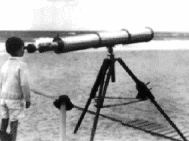Astrophotography through a
Dobsonian Telescope
 |
"Hier war es lustig; alle Sterne waren wach und
hatten die Augen auf und funkelten, daß der ganze Himmel blitzte. 'Platz
da!' schrie Häwelmann und fuhr in den hellen Haufen hinein."
Theodor Storm: |
The Dobsonian telescope is the first choice for many amateur observers. Large apertures become affordable in Dobsonians, and the truss design guarantees full mobility, so the enormous light gathering power can be used at dark sites.
However, there are two drawbacks to the Dobsonian. First, the scope needs to be pushed to keep an object within the field of view, which becomes especially bothersome at high powers. Second, the Dobsonian cannot do astrophotography; it is restricted to visual observing.
Recently, computer controlled drive systems, such as the "ServoCat", have become available. Together with digital setting circles, they provide full goto and tracking capability, thereby eliminating the first drawback of the Dobsonian. The "ServoCat" is also capable of autoguiding (ST 4 compatible). After enjoying my 18" Obsession, equipped with this drive system, visually for two years, I decided to go into ccd astrophotography and see, if the "ServoCat" could overcome the second drawback of the Dobsonian as well and make imaging possible.
First I tried unguided imaging with a modified webcam (SC 1). Planetary imaging as well as video imaging with life images on the laptop screen was easily feasible. But for exposure times longer than 15 seconds, autoguiding proved necessary.
My aim was to use the light gathering power of the large mirror for long term exposure imaging of deep sky objects. In March 2005 I purchased a used SBIG ST 9E camera with a second, built-in chip for autoguiding. The large pixel size of the imaging chip (20 microns) is commensurate for the focal length of 2050 mm. The autoguider cable could be directly plugged into the "ServoCat". No technical modifications were necessary.
The 18" Obsession is a wooden instrument with production tolerances regarding, for instance, the orthogonality of the optical axes. Thus I expected difficulties concerning autoguiding. However, I was amazed to see how well autoguiding worked. If the scope is levelled and the truss tube balanced, the drive system makes the scope follow the guide star with good precision and for indefinite periods of time. I achieved images with a magnitude around 20, as a comparison with the USNO charts shows.
Currently, the limiting factor for me is not autoguiding but field rotation. Depending on where in the sky the telescope points, single frame exposure times cannot excede 1 - 2 minutes without showing signs of rotation. Thus I take multiple short exposures, derotate and stack them with AstroArt software. Software derotation works well, but puts limits on overall exposure times. If the individual frames are turned too far against each other, the software has difficulty aligning them properly. Also, since field rotation rapidly increases at altitudes higher than 50 degrees, my imaging so far is restricted to objects lower in the sky where seeing and transparency is less than optimal. All images at this page were taken with the objects at low altitude and overall exposure times from 10 - 35 minutes.
An electro-mechanical derotator (as offered by Optec) would put off these restrictions. Inserted between the focusser and the camera, it turns the camera at exactly the object's rate of rotation. Fellow Dobsonian astrophotographers have realized exposure times of up to one hour, using a derotator. This appliance would probably make a good future investment for me too.
This page contains the results of my work so far. It is not meant to show beautiful and exceptional images, but to make Dobsonian astrophotography known to amateur astronomers, and to document for those interested what to expect from a setup like mine and with a beginner's skills.